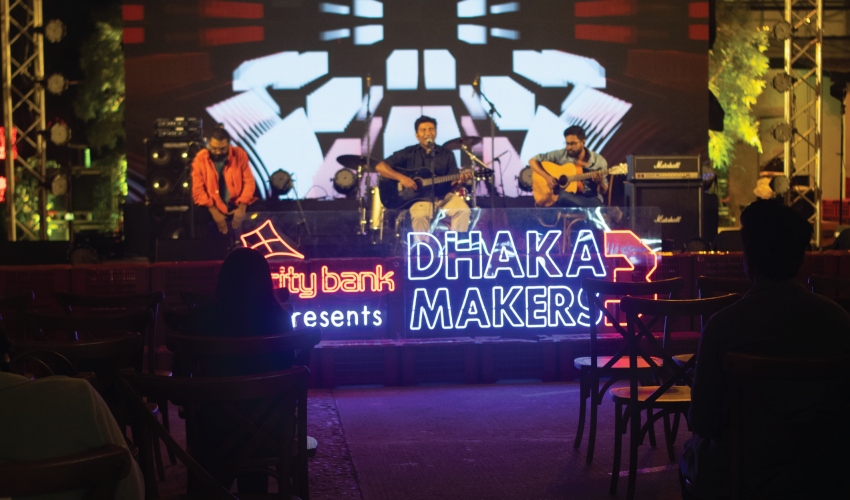Visiting Dhaka Makers 3
Ayman Anika
At first glance, Dhaka Makers 3 seemed like an artist’s utopia – an expanse of stalls buzzing with color, textures, and a hum of conversation that spoke of passion rather than just commerce. But beyond the obvious charm of handmade wares and carefully arranged booths, the five-day festival – held from 30 January to 3 February 2025 – at Aloki Convention Center was a statement. It was an assertion that Bangladesh’s creative community is not just surviving – it is thriving, innovating, and demanding to be seen.
Craft and commerce in harmony
Walking through the marketplace felt like stepping into an anthology of Bangladesh’s artisanal heritage. Every booth held not just products but philosophies – brands built on sustainability, craftsmanship, and a reverence for tradition. The air carried the scent of raw cotton, polished wood, and something indefinably warm – perhaps the satisfaction of makers finally having an audience that appreciated the depth of their work.
Some stalls exuded minimalism, with delicate ceramic pieces or intricate sketches arranged with museum-like precision. Others were a celebration of maximalist energy – fabrics spilling out, handmade jewelry dangling from every corner, artisans weaving, painting, and carving in real time, turning the market into a live studio. This wasn’t just retail; it was a performance of skill, an exhibition of Bangladesh’s ever-evolving artistic language.
Yet, for all the charm, the festival wasn’t a mere nostalgia trip. The products weren’t relics of a past fighting to stay relevant; they were evidence of how heritage and innovation can coalesce. Handwoven textiles found modern silhouettes. Discarded coconut shells were reborn as elegant home décor. Even age-old batik patterns were reimagined into contemporary designs, proving that tradition isn’t static – it adapts, absorbs, and reinvents itself when given the right stage.
The makers and their stories
Among the artisans was Horendro Kumar Das, an elderly craftsman sitting quietly amidst the bustle, his hands moving instinctively over woven strips of shitol pati. There was an unspoken wisdom in his fingers, a rhythm honed over half a century. When he spoke, his voice carried both pride and quiet concern. “I have been making shitol pati since I was a boy,” he said, his eyes scanning the crowd. “It is a craft passed down through generations, but today, fewer young people are taking it up. Events like this help people appreciate our work, and maybe, some will be inspired to carry on this tradition.”
Das’s words lingered, a reminder that while such events celebrate the richness of heritage, they also expose its fragility. Who, after all, will continue these traditions when the hands that have kept them alive grow weary?
More than a market: an experience
The magic of Dhaka Makers 3 extended beyond the stalls. Workshops and live demonstrations blurred the line between observer and creator. Calligraphy sessions became spontaneous art therapy corners, while rickshaw artists painted everyday objects with a flair that made them seem almost sacred. Even terracotta doll-making turned into a lesson in patience and precision.
The festival’s layout was deliberate, an unspoken choreography that guided visitors from appreciation to participation. One moment, you were watching an artist at work; the next, you were shaping clay, threading a loom, or sketching on handmade paper. The transition was seamless, making artistry feel less like an exclusive craft and more like an accessible language anyone could learn.
Music, movement, and the festival’s pulse
As the sun set, the space transformed yet again. The marketplace’s daytime bustle gave way to an evening of music – a different kind of craft, but one that resonated just as deeply. The lineup was an eclectic mix, from folk melodies that seemed to carry the weight of generations to contemporary beats that made the audience sway. The closing act, the Rehman Duo, left a lingering harmony in the air, a fitting end to a festival that had been, from start to finish, a living, breathing composition of creativity.
Dhaka Makers 3 made the invisible visible – the artisans whose work often exists in the margins, the traditions at risk of fading, the potential of a future where craftsmanship and sustainability shape the mainstream market rather than exist as niche curiosities.
As the stalls were dismantled and the last notes of music faded, what remained was not just the afterglow of a well-organized festival but a question: How do we ensure that the spirit of Dhaka Makers 3 extends beyond these five days? Perhaps the answer lies in not just buying handcrafted goods but in understanding their stories, supporting their makers, and ensuring that art and tradition continue to find their place in a rapidly modernizing world.
- mahjabin rahmanhttps://mansworldbangladesh.com/author/mahjabin/
- mahjabin rahmanhttps://mansworldbangladesh.com/author/mahjabin/
- mahjabin rahmanhttps://mansworldbangladesh.com/author/mahjabin/
- mahjabin rahmanhttps://mansworldbangladesh.com/author/mahjabin/













